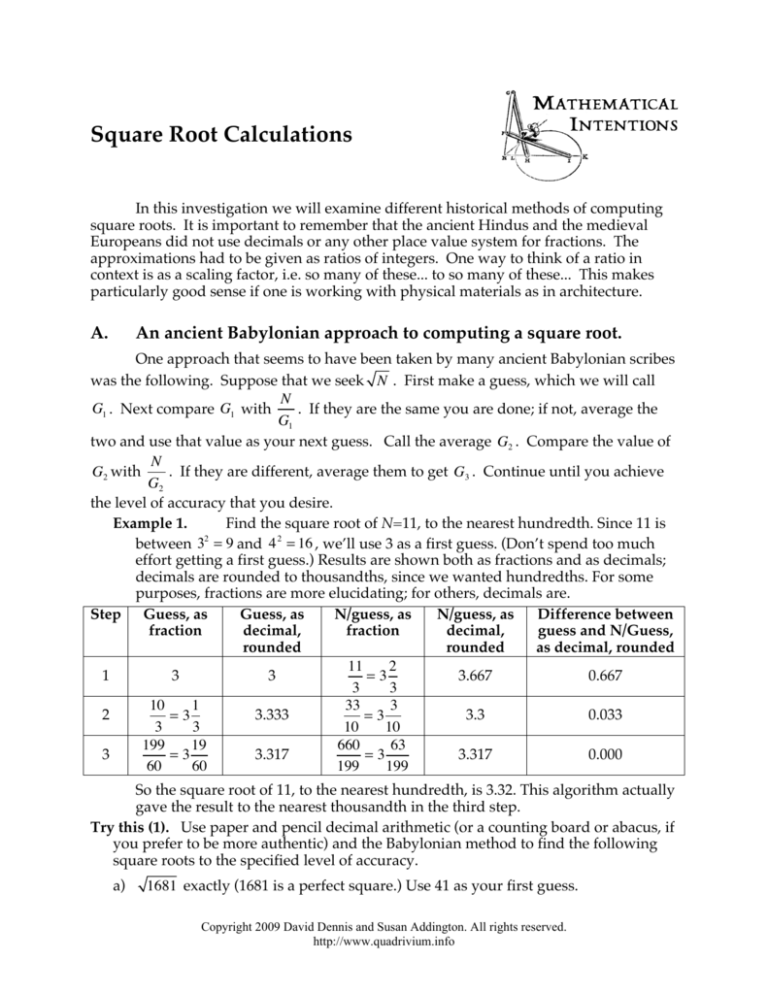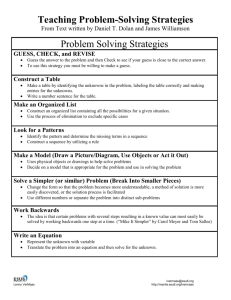
Square Root Calculations
In this investigation we will examine different historical methods of computing
square roots. It is important to remember that the ancient Hindus and the medieval
Europeans did not use decimals or any other place value system for fractions. The
approximations had to be given as ratios of integers. One way to think of a ratio in
context is as a scaling factor, i.e. so many of these... to so many of these... This makes
particularly good sense if one is working with physical materials as in architecture.
A.
An ancient Babylonian approach to computing a square root.
One approach that seems to have been taken by many ancient Babylonian scribes
was the following. Suppose that we seek N . First make a guess, which we will call
N
G1 . Next compare G1 with
. If they are the same you are done; if not, average the
G1
two and use that value as your next guess. Call the average G2 . Compare the value of
N
G2 with
. If they are different, average them to get G3 . Continue until you achieve
G2
the level of accuracy that you desire.
Example 1.
Find the square root of N=11, to the nearest hundredth. Since 11 is
2
between 3 = 9 and 4 2 = 16 , we’ll use 3 as a first guess. (Don’t spend too much
effort getting a first guess.) Results are shown both as fractions and as decimals;
decimals are rounded to thousandths, since we wanted hundredths. For some
purposes, fractions are more elucidating; for others, decimals are.
Step Guess, as
Guess, as
N/guess, as
N/guess, as
Difference between
fraction
decimal,
fraction
decimal,
guess and N/Guess,
rounded
rounded
as decimal, rounded
11
2
1
3
3
3.667
0.667
=3
3
3
10
1
33
3
2
3.333
3.3
0.033
=3
=3
3
3
10
10
199
19
660
63
3
3.317
3.317
0.000
=3
=3
60
60
199
199
So the square root of 11, to the nearest hundredth, is 3.32. This algorithm actually
gave the result to the nearest thousandth in the third step.
Try this (1). Use paper and pencil decimal arithmetic (or a counting board or abacus, if
you prefer to be more authentic) and the Babylonian method to find the following
square roots to the specified level of accuracy.
a)
1681 exactly (1681 is a perfect square.) Use 41 as your first guess.
Copyright 2009 David Dennis and Susan Addington. All rights reserved.
http://www.quadrivium.info
Mathematical Intentions, Square Roots, page 2
b)
676 exactly. Find a first guess mentally.
c)
5 , to the nearest hundredth.
Was the long division as bad as you thought? Why?
Try this (2). (Detour into number theory; optional.) Use paper and pencil fraction
arithmetic (not decimals) to find the square root of 2, starting with a first guess of 1.
It’s easier to use improper fractions. Find a pattern in the numerators and
denominators of the guesses; do as many steps as you need to detect a pattern. Can
you express this pattern algebraically? Does it adapt to the square roots of other
integers?
Try this (3). Experiment with the GeoGebra (spreadsheet) file BabylonSqrt.html. Think
about these questions.
a) How many decimal places of accuracy do you get at each step?
b) How critical is it to get a good first guess? Compute the square root of the same
number with various first guesses, and see how many steps it takes to get a
specified level of accuracy. Try some really terrible first guesses, like 10,000 for
the square root of 2.
c) Find the square roots of some really large (such as 1,428,036) and some really
small (such as 0.00000000023456) numbers, and use these results to practice
estimating square roots of large and small numbers.
B.
An ancient Hindu square root method
The following is an example of a general geometrical method used by the ancient
Hindus for finding a series of rational approximations to square roots. It was described
by Baudhayana in the Sulbasutra (800-500 BC). The method has the flavor of carpentry
or stonemasonry in that it gives the size of a series of trimmings to be made to a square
that is too large. However the exactitude of the calculations gives this method a
mathematical value that goes beyond its architectural origins.
Starting with a 2 x 2 square with an area of 4 sq. units, we seek to construct a
square with an area of 2 sq. units by recursively trimming off excess area.
Starting with a 2 x 2 square,
Excess Area = 2 sq. units
Trim off strips of width 1/2 (four
pieces)
Overlap of 1/2 x 1/2 means that we
did not trim off enough.
Side of new smaller square = 2 −
1 3
= = 1.5
2 2
Copyright 2009 David Dennis and Susan Addington. All rights reserved.
http://www.quadrivium.info
Mathematical Intentions, Square Roots, page 3
Continuing in this fashion, we take the excess area and divide it up into strips
which can be laid out to fit exactly along two sides of the square in an attempt to trim
1 1
off the appropriate amount of excess area. The excess area at this step is a × square.
2 2
1 1
We now divide this square into 6 strips (each × ) and trim off the square.
2 12
1.5 x 1.5 square
Excess Area = 1/2 x 1/2 =
1/4 sq. units
Excess Area
divided into six
equal strips
Trim off strips of width 1/12 (six
pieces)
Over lap of 1/12 x 1/12 means that
again we did not trim off enough.
1
1
1 1 17
5
−
=2− −
=
= 1+
≈ 1.41666667
2 2⋅6
2 12 12
12
Continuing in this fashion, we again take the excess area and divide it up into
strips that can be laid out to fit exactly along two sides of the square in an attempt to
1
1
trim off the appropriate amount of excess area. The new excess area is a
× square.
12 12
1
1
We now divide this square into 34 strips (each of size
). Fitting 17 of these
×
12 408
strips on each side, we again trim off the square.
Side of new smaller square = 2 −
1
1
1
−
−
2 2 ⋅ 6 2 ⋅ 6 ⋅ 34
1 1
1
=2− −
−
2 12 408
577
169
=
= 1+
≈ 1.41215686
408
408
Continuing in this fashion, we again take the excess area and divide it up into
strips that can be laid out to fit exactly along two sides of the square in an attempt to
1
1
trim off the appropriate amount of excess area. The new excess area is a
×
408 408
1
1
square. We now divide this square into 1154 strips (each of size
) and
×
408 470832
again trim off the square.
Side of new smaller square = 2 −
Copyright 2009 David Dennis and Susan Addington. All rights reserved.
http://www.quadrivium.info
Mathematical Intentions, Square Roots, page 4
1
1
1
1
−
−
−
2 2 ⋅ 6 2 ⋅ 6 ⋅ 34 2 ⋅ 6 ⋅ 34 ⋅1154
1 1
1
1
=2− −
−
−
2 12 408 470832
665857
195025
=
= 1+
≈ 1.414213562
470832
470832
Side of new smaller square = 2 −
Try this (4). Use the Hindu method to find the square root of another integer, such as 3
or 5.
Try this (5). Compare with the steps for the square root of the same number, using Try
this (2).
Try this (6). Experiment with various numbers in HinduSqrt.html to see the size of the
pieces that are being removed at each step. This demonstration shows 3 steps of
trimming. Zoom in on the upper right corner to see the overlap.
C.
A square root method used by 10th century European architects.
Recently an architecture student at UCLA, Sukuru Yuksel, investigated how
tenth century European architects approximated square roots. He came upon the
following procedure.
Consider the geometric sequence 1, 2, 4, 8, 16, 32, . . . with a constant ratio of 2.
Next consider how one might insert geometric means into the sequence. That is to say
how might one refine or interpolate the sequence in such a way that it remains a
geometric sequence (i.e. consecutive terms have a constant ratio). What is wanted is the
sequence:
1,
2, 2, 2 2, 4, 4 2, 8, 8 2, 16, 16 2, 32, …
Now one starts by making a guess at 2 . For example let us start with the crude
guess 2 ≈ 1 . The sequence then becomes: 1, 1, 2, 2, 4, 4, 8, 8, 16, 16, 32, . . . Starting
with this sequence, one then forms a new sequence in which each new term is the sum
of two consecutive terms in the previous sequence (in the same way that one generates
Pascal's triangle). By doing this each new sequence comes closer and closer to having a
common ratio of 2 . For example:
1
1
2
2
4
4
8
8
16
16
32
32
2
3
4
6
8
12
16
24
32
48
64
5
7
10
14
20
28
40
56
80
112
12
17
24
34
48
68
96
136
192
29
41
58
82
116 164 232 328
70
99
140 198 280 396 560
169 239 338 478 676 956
408 577 816 1154 1632
985 1393 1970 2786
2378 3363 4756
5741
8119
Copyright 2009 David Dennis and Susan Addington. All rights reserved.
http://www.quadrivium.info
Mathematical Intentions, Square Roots, page 5
Don’t do the final addition. The square root of 2 is approximately the ratio of the
8119
final two numbers:
= 1.414213552… . A modern calculator gives 2 ≈ 1.414213562 .
5714
That is to say, the last ratio in the table above is an approximation to 2 that is accurate
to seven decimal places.
Note that this algorithm could be performed easily with Roman numerals.
See the GeoGebra file EurSqrt.html.
Try this (7).
a) If you haven’t already done this, use each of the three methods to approximate
the square root of the same number, such as 2 or 5 . Compare and contrast
the methods. Consider the issues of format, simplicity, accuracy, and efficiency.
Comment on any patterns that you notice in any of the approximation schemes.
b) Experiment with using different first guesses in three different methods. What is
the effect of using a different starting point?
c) Try to come up with some reasoning that would justify each of the three
methods.
d) Is it possible to modify any of the three processes so as to compute rational
approximations to a cube root? How might you go about doing this?
Try this (8). (For further practice) Construct your own spreadsheets for each of the
three methods.
Copyright 2009 David Dennis and Susan Addington. All rights reserved.
http://www.quadrivium.info







